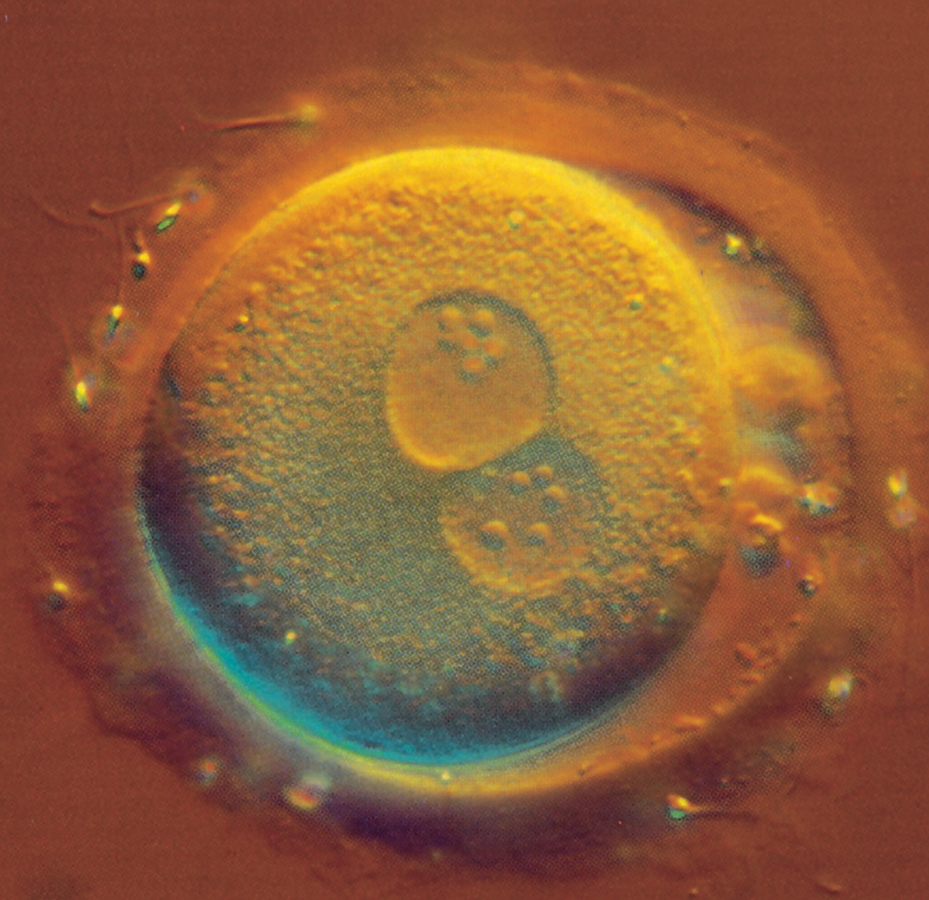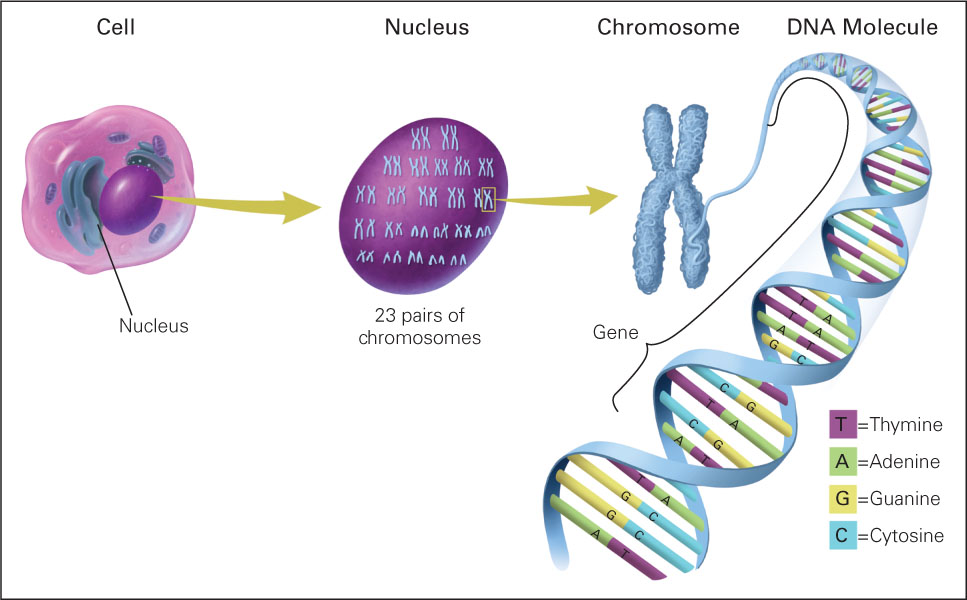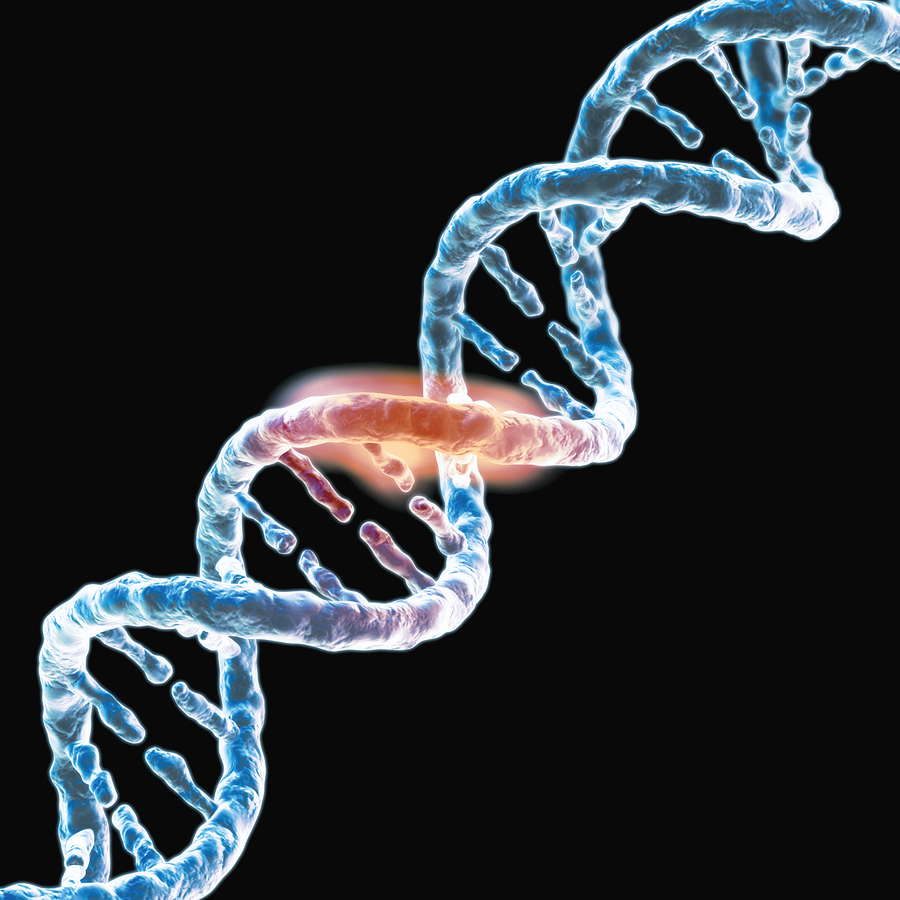 The Genetic Code
The Genetic Code
gamete A reproductive cell; that is, a sperm or ovum that can produce a new individual if it combines with a gamete from the other sex to make a zygote.
zygote The single cell formed from the union of two gametes, a sperm and an ovum.
A reproductive cell is called a gamete. Every person begins life as a single cell, called a zygote; the zygote is the combination of two gametes, one sperm (sperm is an abbreviation of spermatozoon, plural spermatozoa, from the Greek word for seed) and one ovum (plural, ova, from the Greek for egg). The zygote contains all a person’s genes, which affect every aspect of development lifelong. Many people have misconceptions about heredity, so the beginning of this chapter is crucial to understanding human development.

What Genes Are
First, we review some biology. All living things are composed of cells. The work of cells is done by proteins. Each cell manufactures certain proteins according to instructions stored by molecules of deoxyribonucleic acid (DNA) at the heart of each cell. These coding DNA molecules are on a chromosome.
deoxyribonucleic acid (DNA) The chemical composition of the molecules that contain the genes, which are the chemical instructions for cells to manufacture various proteins.
chromosome One of the 46 molecules of DNA (in 23 pairs) that virtually each cell of the human body contains and that, together, contain all the genes. Other species have more or fewer chromosomes.
gene A small section of a chromosome; the basic unit for the transmission of heredity. A gene consists of a string of chemicals that provide instructions for the cell to manufacture certain proteins.
Humans have 23 pairs of chromosomes (46 in all), which contain the instructions to make all the proteins that a person needs for life and growth (see Figure 3.1). The instructions in the 46 chromosomes are organized into genes, with each gene usually located at a specific spot on a particular chromosome. Humans have between 18,000 and 23,000 genes, and each gene directs the formation of specific proteins made from a string of 20 amino acids.
Especially for Scientists A hundred years ago, it was believed that humans had 48 chromosomes, not 46; 20 years ago, it was thought that humans had 100,000 genes, not 20,000 or so. Why?
Response for Scientists: There was some scientific evidence for the wrong numbers (e.g., chimpanzees have 48 chromosomes), but the reality is that humans tend to overestimate many things, from the number of genes to their grade on the next test. Scientists are very human: They tend to overestimate until the data prove them wrong.

FIGURE 3.1
How Proteins Are Made The genes on the chromosomes in the nucleus of each cell instruct the cell to manufacture the proteins needed to sustain life and development. The code for a protein is the particular combination of four bases, T-A-G-C (thymine, adenine, guanine, and cytosine).allele A variation that makes a gene different in some way from other genes for the same characteristics. Many genes never vary; others have several possible alleles.
The instructions for making those amino acids are on about 3 billion pairs of chemicals, called base pairs, arranged in precise order. A small variation—such as repeated pairs, or one missing pair—changes the gene a tiny bit. Although all humans have most of the same genes with identical codes, those tiny variations of certain genes make each person unique. Each variation of a particular gene is called an allele of that gene.
RNA (ribonucleic acid, another molecule) and additional DNA surround each gene. In a process called methylation, this additional material enhances, transcribes, connects, empowers, silences, and alters genetic instructions (Shapiro, 2009). This nongenetic material used to be called junk—but no longer. Thousands of scientists are now seeking to discover exactly what these molecules do (Wright & Bruford, 2011; Volders et al., 2013). We do know that methylation continues throughout life, and it can alter a gene’s expression, not only prenatally but after birth as well. This is part of epigenetics, mentioned in Chapter 1 as well as later in this chapter.
Variations

It is human nature for people to notice differences more than commonalities. Hence many scientists seek genetic reasons for the fact that no two people look or act exactly alike. Differences begin with alleles, which can be caused by transpositions, deletions, or repetitions of those base pairs, making some genes polymorphic (literally, “many forms”) or, more formally, single-nucleotide polymorphisms (abbreviated SNPs, pronounced “snips”).
Usually genes have only one set of instructions (no alleles), but polymorphic genes can have two, three, or more versions. Most alleles seem inconsequential; some cause only minor differences (such as the shape of an eyebrow or the shade of the skin); and a few are notable, even devastating, but the devastating ones are rare. Several destructive alleles in combination with specific epigenetic conditions make a person develop schizophrenia, or diabetes, or whatever (Plomin et al., 2012).
Some variation springs from the simple fact that it takes two people to make one new person. Each parent contributes half the genetic material; the 23 chromosomes with their thousands of genes from one parent match up with the 23 from the other, forming identical or nearly identical pairs. Thus chromosome 1 from the sperm connects with chromosome 1 from the ovum, chromosome 2 with chromosome 2, and so on.
Each gene pairs with a counterpart gene from the other parent, and the interaction between the two members of each pair determines the inherited traits of the future person. Since the alleles from the father often differ from the alleles from the mother, their combination may be different from either parent. Thus each new person is a product of both parents but unlike either one.
Diversity at conception is increased by another fact: When a man or woman makes sperm or ova, and then their chromosomes pair up when they join, some genetic material is transferred from one chromosome to the other, so that “even if two siblings get the same chromosome from their mother, their chromosomes aren’t identical” (Zimmer, 2009, p. 1254). All these kinds of genetic diversity help societies, because creativity and even species survival is enhanced when one person is unlike another, although there are benefits when genes are shared as well (Ashraf & Galor, 2011).
genome The full set of genes that are the instructions to make an individual member of a certain species.
The entire packet of instructions to make a living organism is called the genome. There is a genome for every species and variety of plant and animal—even for every bacteria and virus. Knowing the genome of the human species is only a start (it was decoded in 2001) at understanding the genetics of people, since each individual has a slightly different set of those 3 billion base pairs.
SUMMING UP
The human genome contains approximately 20,000 genes on 46 chromosomes, using 3 million base pairs of code to make a person. Some genes, called alleles, are polymorphic. Because of small differences in their genetic codes, each person is unlike any other. The result is that each person is unique yet similar to all other humans. The entire instruction code is the genome, contained in a single cell, the zygote.